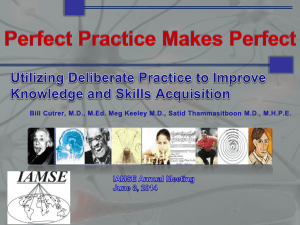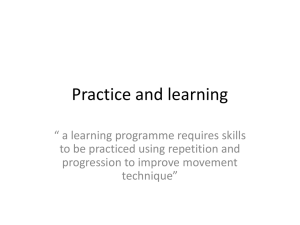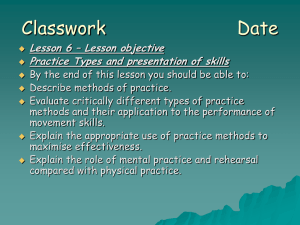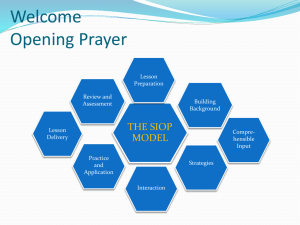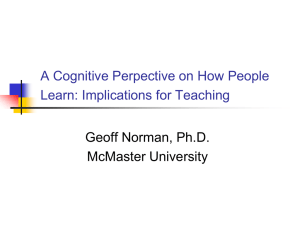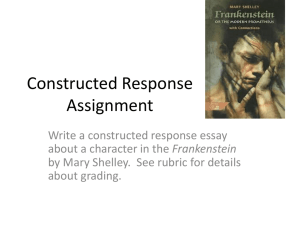Spaced v. Massed PowerPoint
advertisement
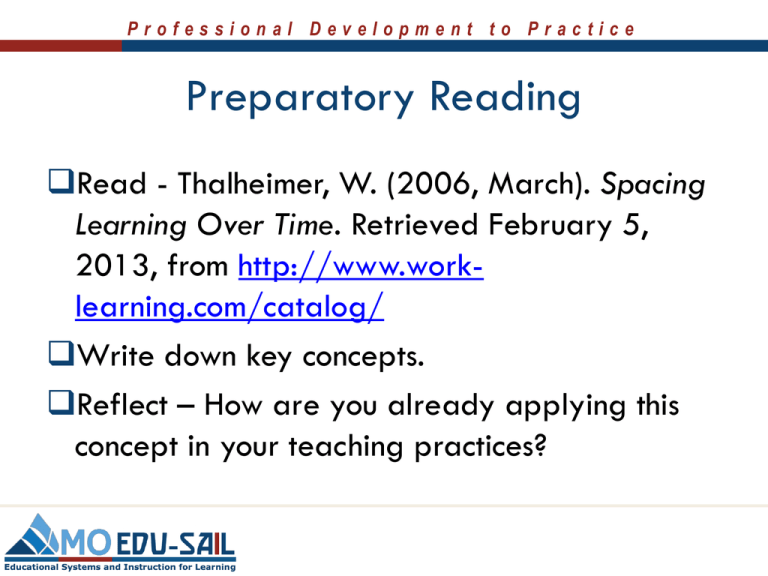
Professional Development to Practice Preparatory Reading Read - Thalheimer, W. (2006, March). Spacing Learning Over Time. Retrieved February 5, 2013, from http://www.worklearning.com/catalog/ Write down key concepts. Reflect – How are you already applying this concept in your teaching practices? Professional Development to Practice Spaced vs. Massed Practice An Effective Teaching/Learning Practice The contents of this presentation were developed under a grant from the US Department of Education to the Missouri Department of Elementary and Secondary Education (#H323A120018). However, these contents do not necessarily represent the policy of the US Department of Education, and you should not assume endorsement by the Federal Government. Professional Development to Practice Professional Development to Practice Effective Teaching/ Learning Practices (EP) Overview and Purpose of EP Spaced versus Massed Practice Assessment Capable Learners Spaced versus Massed Reciprocal Teaching Feedback Professional Development to Practice Learning Objectives Understand the research and core components of spaced versus massed practice Determine the types of concepts which best fit spaced practice Determine the amount of space between repetition or practice of concepts Apply spaced practice to identified concepts. Plan for classroom application Professional Development to Practice Pre/Post Assessment Please complete the Pre Assessment Consultant will collect and compare to the Post Assessment that will be given after the training Professional Development to Practice Expectations For Training To incorporate effective spaced practice into teaching/learning practices (Use with factual information.) Professional Development to Practice Session At-A-Glance Research and core components Concepts that best fit spaced practice Schedule of spaced practice Application Plan for implementation Professional Development to Practice Meeting Norms Be RespectfulBe an active listener. Use notes for side bar. Be ResponsibleBe on time for sessions and after breaks Silence cell phones—reply appropriately Be a Problem SolverAsk questions as needed to clarify concepts or directions Professional Development to Practice Introductions/ Reading Reflection Turn to a shoulder partner and discuss: Major concepts learned in the assigned reading Ways in which spaced practice is already being used in your classroom Concepts in which this practice could be applied Professional Development to Practice What are Effective Teaching/Learning Practices? Effective teaching/learning practices at the classroom level are evidence-based effective methods that are not content related and when implemented with fidelity and informed through data can produce positive, sustained results for every student. Professional Development to Practice Is Spaced versus Massed an Effective Teaching/Learning Practice? Research on Spaced versus Massed practice began in 1885 with Ebbinghaus. Research literature focuses spaced practice use primarily on motor skills, vocabulary development, and learning math facts. Spaced repetitions have been shown to be more effective than massed practice on long term retention of concepts. Professional Development to Practice Spaced vs. Massed Practice “Repetition of information improves learning and memory. No surprise there. However, how information is repeated determines the amount of improvement. If information is repeated back to back (massed or blocked presentation), it is often learned quickly but not very securely (i.e., the knowledge fades fast). If information is repeated in a distributed fashion or spaced over time, it is learned more slowly but is retained for much longer.” Roediger III, H. L., & Pyc, M. A. (2012) Professional Development to Practice Definitions Massed Practice – Conditions are those in which individuals practice a task continuously without rest. (Cramming) Spaced Practice – Conditions are those in which individuals are given rest intervals within the practice sessions. (Distributed or interleaving) Professional Development to Practice Spaced vs. Massed Practice 2 meta-analyses, 63 studies, Rank 13th (Self-Reported Grades) (.71 effect size) Professional Development to Practice Spaced vs. Massed Practice and Missouri Teacher Standards Spaced vs. Massed Practice aligns with the following Missouri Teacher Standards: Standard 1, Quality Indicator 2 Standard 2, Quality Indicator 3 Standard 6, Quality Indicator 4 Professional Development to Practice Spaced vs. Massed Practice and Missouri Teacher Standards Standard 1: Content knowledge aligned with appropriate instruction. 1.2: Student engagement in subject matter Standard 2: Student Learning, Growth and Development 2.3: Theory of learning Standard 6: Effective Communication 6.4: Technology and media communication tools Professional Development to Practice Research 5th grade vocabulary (Sobel, Cepeda & Kapler, 2011) One group reviewed terms a 2nd time immediately after initial learning (massed). One group reviewed 1 week after initial learning (spaced). Test given 5 weeks after last review revealed students remembered 20.8% of vocabulary with spaced practice versus 7.5% with massed practice Professional Development to Practice Research High School students learning French vocabulary (Bloom & Shuell, 1981) Words studied for 30 minutes in one day (massed) Words studied for 10 minutes on 3 consecutive days (spaced) Spaced studying group recalled 35% more words on a recall test 4 days after last review Professional Development to Practice Research 1st grade phonics learners (Seabrook, Brown, & Solity, 2005) Spaced practice = 2 minutes per day for 3 consecutive days Massed practice = 6 minutes on one day Spaced learning group showed better knowledge of letter sounds and better reading ability when tested 2 weeks later Professional Development to Practice Research 3rd graders learning math facts (Rea & Modigliani, 1985) Spaced practice tested 70% correct Massed practice tested 53% correct Professional Development to Practice Spaced Practice Core Components Use on factual information (e.g. vocabulary, math facts, spelling) Space the practice or repetition of the learning over time Allowing time between practice OR Teach a different concept between practice Professional Development to Practice Spaced Practice Core Components At least 3 repetitions for each concept Repetitions need not be identical Vary examples and context Vary the mode – paraphrasing, discussion, role play Vary the media – video, computer, internet Professional Development to Practice Examples Students practice math facts flash cards at the beginning of each math class rather than spend an entire class period practicing Key terms are reviewed for a long term topic/project every Monday Topics covered in previous learning sessions are reviewed at the beginning of class with the use of a quiz, bell question, or activity Include items from previous learning for homework Use cumulative tests so students will review and study essential information needed for long term recall Professional Development to Practice A-B Teach Get into pairs One person is A and one person is B A teaches Massed Practice to B B teaches Spaced Practice to A Include definition, core components and examples Professional Development to Practice Why is Spaced Practice Effective? Wider spacing requires extra cognitive effort to recall Wider spacing creates multiple retrieval routes that aids remembering Spacing with a variety of modes, media, and examples reduces learning fatigue and therefore increases student engagement Spacing increases the chance the student will utilize concept between practice sessions Professional Development to Practice What is the Ideal Spacing? The ideal spacing should be 15-20% ratio of gap to when the students will need to retain the information (or be tested) Example – you begin a unit that will last 6 weeks. You should space time spent on reviewing vocabulary to once a week (6X.20=1.2) Professional Development to Practice What is the Ideal Spacing? 15-20% is a guideline not an absolute Work within your timelines and class structures to incorporate spaced practice of key concepts and facts associated with your curriculum Longer gaps between review can have powerful effects on retention of material Professional Development to Practice Implementation Example The teaching of the concept “Spaced versus Massed practice” 1. Introduced to concept with a reading, highlighting of key concepts, and reflection 2. Concept is presented and discussed 3. Participants are expected to apply concept to their classroom 4. Follow up There is space or a gap between each session Professional Development to Practice Implementation Example Your students will need to know specific math concepts for the MAP test in the spring You introduce the first concept in September As each additional concept is introduced you review the other concepts with homework, bell question, and/or occasional quizzes. The space between the review is 15-20% of 7 months (gap between initial learning and the test) or every 4 to 6 weeks. (7X.20=1.4) Professional Development to Practice Practice Profile Missouri Collaborative Work Practice Profile Foundations present in the implementation of each essential function: Commitment to the success of all students and to improving the quality of instruction. Sp ac ed ver su s M a sse d P r act ice Pr o f il e Far from Close to Proficient Proficient (Skill is emerging, but Exemplary proficiency (Follow-up not yet to ideal Essential Function Ideal Implementation Proficient professional proficiency. development and Coaching is coaching is recommended.) critical.) Educator provides Educator plans for and provides instruction Educator consistently Instruction and repeated instruction and and practice in a repeated fashion consistently plans for instruction practice are not distributes practice of a spaced over time. and practice in a spaced over time. 1 skill/concept over repeated fashion extended period of time. consistently spaced over time. Professional Development to Practice Implementation Practice Choose a concept/set of facts related to your curriculum and determine how you will structure spaced practice How much space will be between practice? Will you vary the practice or keep it the same? Will you use a bell question, homework, or cumulative tests to aid in your spaced practice? Be prepared to share out Professional Development to Practice Implementation Fidelity Spaced versus Massed Instruction Implementation Fidelity Checklist Instructions: This checklist is designed for frequent checking on the fidelity of implementing spaced versus massed instruction. Fidelity should be monitored “early and often” (Harn, Parisi, & Stoolmiller, 2013) especially early in implementation. It is recommended that educators selfmonitor their fidelity daily during early implementation. A on-site coach may also observe and use this form to record fidelity. Completed checklists can be discussed during coaching conversations. If the number of 'Yes' items is repeatedly fewer than four(4), then coaching may be beneficial. Date: 1 Teacher (I)… Includes spacing of instruction in lesson plans when teaching factual information (e.g. math and vocabulary). 2 Includes at least 3 repetitions of practice in lesson plans spaced over the day. 3 Varies the type (mode, media, context) of the repeated practice and instruction. Collects data on spacing of instruction and practice opportunities. 4 Total Yes Partially No If partially or no, explain. Professional Development to Practice Implementation Schedule Concept or skill for spaced practice _______________________________________________________________ Method of Review Date Date Date Date Date Date Date Reviewed Reviewed Reviewed Reviewed Reviewed Reviewed Reviewed Professional Development to Practice Potential Challenges What are potential challenges to implementation? List these on a post it note and put on chart paper. Professional Development to Practice Here’s what. So what? Now what? Complete the graphic organizer. Share at table in Round Robin fashion. How will the information learned today influence your teaching? List 3 ways you will use this practice. Be specific in your application. Professional Development to Practice Next Steps: Action=Results Next Steps: Actions = Results Content Focus Collaborative Data Teams Effective Teaching/Learning Practices School: _________________________ Common Formative Assessment Data-based Decision-making Date Next Steps Form Written:_______________________________ Teams (e.g. grade level or content): _________________________________________________________________________________ Action Planned What? Responsible Person(s) Who? Timeline When? Resources/Support Needed Results So What? What steps will you take to start implementing? Professional Development to Practice References/Resources Carpenter, S.K., Cepeda, N.J., Rohrer, D., Kang, S.K., Pashler, H. (2012). Using Spacing to enhance diverse forms of learning: Review of recent research and implications. Educational Psychology, 24, 369-378. Cepeda, N.J., Vul, E., Rohrer, D., Wixted, J.T., Pashler, H. (2008). Spacing effects in learning: A temporal ridgeline of optimal retention. Psychological Science, 19(11), 1095-1102. Donovan, J.J., Radosevich, D.J. (1999). A meta-analytic review of the distribution of practice effect: Now you see it, now you don’t. Journal of Applied Psychology, 84(5), 795-805. Pavlik, P.I., Anderson, J.R. (2008). Using a model to compute the optimal schedule of practice. Journal of Experimental Psychology, 14(2), 101-117. Sobel, H.S., Cepeda, N.J., Kapler, I.V. (2011). Spacing effects in real-world classroom vocabulary learning. Applied Cognitive Psychology, 25, 763-767.
